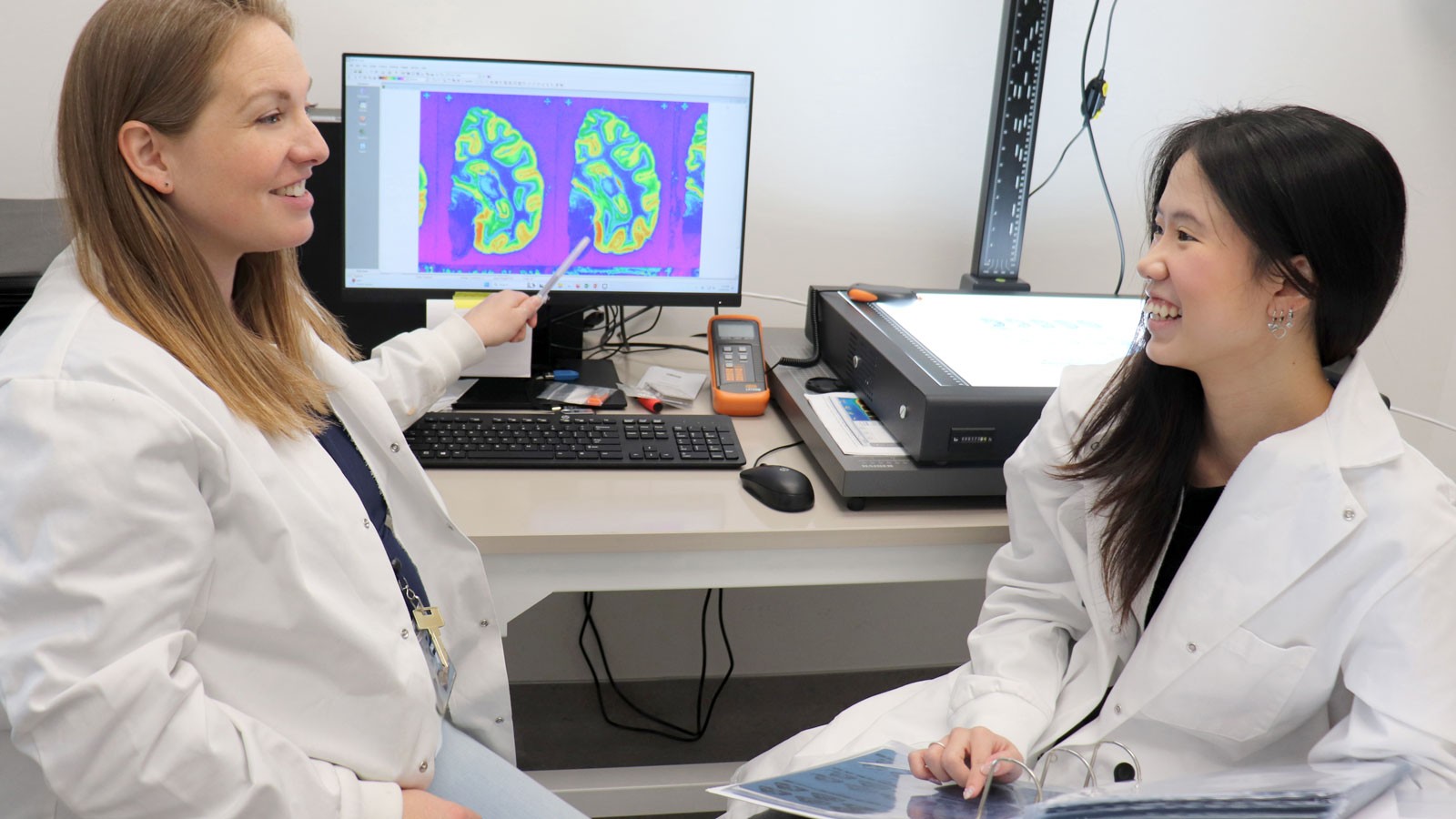Lost Loves: USU Neuroscientists Learn About Grief From Widowed Coyotes
Undergraduate Research Fellow Rachel Tong, with Biology faculty mentor Sara Freeman, studies the brain's responses to emotional stress.
By Mary-Ann Muffoletto |
Undergraduate Research Fellow Rachel Tong, right, and Biology faculty mentor Sara Freeman, left, are studying corticotropin-releasing factor in female coyote brains. Tong received URCO and College of Science grants to support her research. (Photo: USU/M. Muffoletto)
Utah State University Honors student Rachel Tong says that prior to working in a neuroscience lab, she gave little thought to the source of her emotions.
“Like everyone, I sometimes feel sad, mad or happy,” says Tong, a human biology and communications studies major with minors in chemistry and psychology. “But I never thought about what was actually happening inside my brain that was driving these responses and feelings.”
With faculty mentor Sara Freeman, assistant professor in USU’s Department of Biology, Tong is delving into brains — not human brains, but the brains of another socially monogamous mammal: the coyote.
“It surprises many people to learn coyotes are a socially monogamous species, as are all wild canid species studied to date,” Freeman says. “This makes coyotes a valuable subject of study.”
Female coyotes rely on their mates to help with each litter. The survival of their offspring has much more chance for success with the cooperation of both parents. Biologists who’ve studied the canids report coyotes generally mate for life and only seek a new partner if a mate dies.
Freeman and her students study adult male-female pairs of coyotes (Canis latrans) housed in the USDA APHIS National Wildlife Research Center Predator Ecology and Behavior Project Field Station in Millville, Utah, along with the brains of deceased coyotes.
Tong, a recipient of a USU College of Science Minigrant in 2023 and a USU Undergraduate Research and Creative Opportunities (URCO) grant for spring 2024, is studying brains from female coyotes that died from natural causes, including some that had live mates and some that lost their mates prior to death.
Her research focuses on a neuropeptide produced in both human and canid brains called corticotropin-releasing factor, or CRF.
“CRF plays a major role in both human and coyote behaviors following stress and anxiety,” Tong says. “In response to stress, including grief, CRF causes the brain’s stress system, known as the hypothalamic-pituitary-adrenal axis, to release cortisol into the bloodstream. Cortisol is a stress hormone that regulates many body processes, and mobilizes the body’s response to stressful or threatening stimuli.”
With her study, Tong is exploring where CRF receptors in the brain are located and if the amounts of these receptors change in the brains of female coyotes that experienced social loss.
To do this, Tong carefully slices 20-micron sections of brain tissue, using an instrument called a cryostat, for microscopic analysis. It’s a skill she’s conscientiously honed since joining Freeman’s lab in fall 2021.
“Each section is about the width of a human hair,” she says.
Tong examines the intricately branching, folding regions of each brain section and, using digital densitometry tools that help to visualize the densest areas of receptor expression, she can identify the location of CRF receptors.
“It’s fascinating and I’m excited to see if we see significant differences in the brains of paired coyotes versus the widowed coyotes,” she says.
An aspiring physician, Tong’s research efforts are now competing with her preparations for taking the MCAT — a step toward applying to medical schools. The Undergraduate Research Fellow has shadowed a pediatrician and an emergency medicine physician.
“I was impressed not only by their knowledge and skills, but also by how they dealt with different cases and established strong patient-provider communications and relationships,” she says.
Since working in Freeman’s lab, Tong has developed an affinity for neuroscience, which is enhanced by her campus efforts to foster social well-being among her fellow students. She serves as the College of Science student representative for the USU Honors Student Advisory Board, which includes working with her peers to foster access and inclusion, along with student success and retention.
Tong is also president of the Biology Undergraduate Student Association, and serves on USU’s International Student Council and with the university’s Asian Student Association. She also volunteers with the iHelp Foundation, the ReadingBud program at Adams Elementary School and at the English Language Center of Cache Valley.
“Helping fellow students feel included, giving encouragement to children struggling to read and sharing experiences with people adapting to a new culture — as I did, when I arrived in the United States — are all ways of helping people feel a sense of belonging and community,” says Tong, who is from Singapore. “It’s been interesting and beneficial to me to interact with different age groups and with people from different cultures. Coming out of a global pandemic, we all need to establish supportive social bonds to be healthy both mentally and physically.”
WRITER
Mary-Ann Muffoletto
Public Relations Specialist
College of Science
435-797-3517
maryann.muffoletto@usu.edu
CONTACT
Rachel Tong
Undergraduate Research Fellow
College of Science
rachel.tong@usu.edu
TOPICS
Research 878stories Biology 165stories Undergraduate Research 157stories Animals 90storiesComments and questions regarding this article may be directed to the contact person listed on this page.







